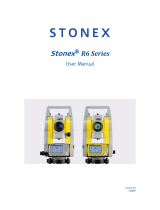
3
· Setting method and content
(1) Reflector: Select it with or . (selection: prism, sheet/none)
(2) PC: Enter the prism constant correction value suited to the target used.
(3) Mode: Select it with or .
(Selection: Fine "S", Rapid "S")
(4) to (7): Temp., Press., Humid., ppm
It is possible to set the atmospheric correction factor in the following two ways.
1. Entering the air temperature, pressure, and humidity (Temp., Press., Humid)
After they are entered, the atmospheric correction factor is automatically calcu-
lated, and [ppm] in (4) is displayed. When parameter "Atmospheric Correction" is
set to "temperature and air pressure," item (3) Humidity cannot be displayed.
2. Directly entering the atmospheric correction factor (ppm).
After the entry, the values for [Temp], [Press.] and [Humid.] are erased.
•Setting the atmospheric correction factor to 0 ppm. [0ppm]
3. After all setting is completed, press
on the Mode line.
"MEAS Mode Screen" is restored.
EXPLANATION Atmospheric correction
•The atmospheric correction is necessary for accurate distance measurement because
the velocity of light in air is affected by the temperature and air pressure.
NOTE: To obtain the average refractive index of the air throughout the measured light
path, you should use the average atmospheric pressure and temperature. Take
care when calculating the correction factor in mountainous terrain. See "27. At-
mospheric Correction for High Precision Distance Measurements" in the
"SET2110/3110/4110 Operator's Manual."
•The SET is designed so that the correction factor is 0 ppm at an air pressure of 1,013
hPa and a temperature of 15°C.
•By inputting the temperature and air pressure values, the correction value is calculated
and set into the memory.
Calculate the atmospheric correction factor as shown in the following formula.
ppm = 278.96 - 0.2904 X air pressure (hPa)
1 + 0.003661 X air temperature (°C)
If the atmospheric correction is not required, set the ppm value to 0.
•It is also possible to enter the atmospheric correction factor by directly entering the ppm
value. To input the ppm value, read the correction factor from the "Atmospheric Correc-
tion Chart" at the end of the "SET2110/3110/4110 Operator's Manual."




















